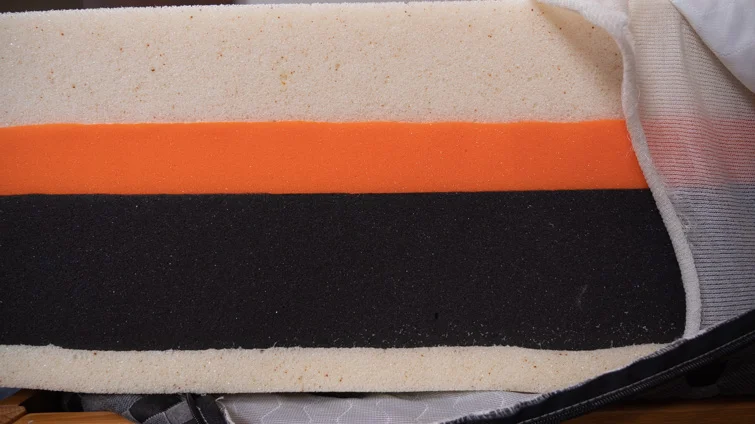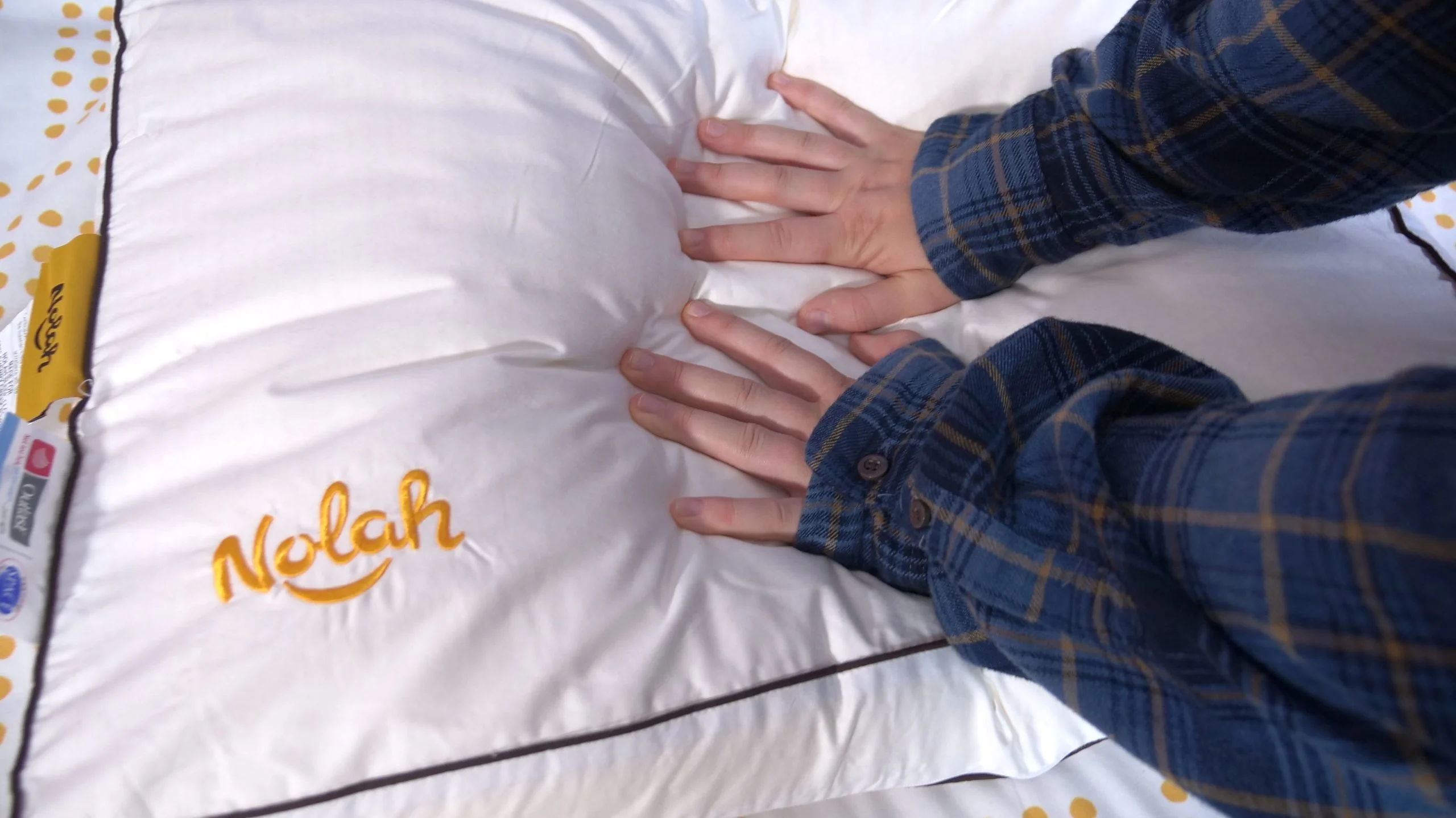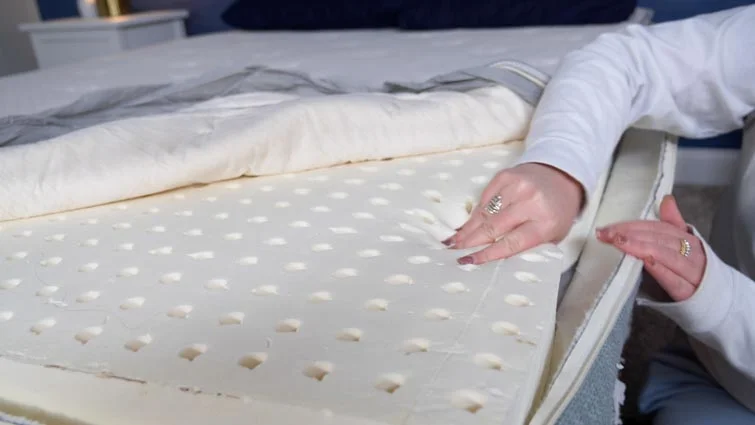
Memory foam mattresses have been growing in popularity over the last 30 years because of their great pressure-relieving qualities and budget-friendly price tags. Traditionally, however, memory foam mattresses have had a bad rep for sleeping hot. Old school memory and poly foam beds can tend to trap heat, but the technology used in modern foam mattresses can help regulate your temperature to keep you cool and comfortable throughout the night. In this article, we’ll unpack the details to help you find memory foam beds that sleep cooler and offer some tips to help prevent your foam bed from trapping heat as you sleep.
Are Memory Foam Mattresses Hot?
People are drawn to foam beds because they are built with thick layers that provide deep pressure relief and plush comfort — but these layers can sleep hot since foam absorbs (and often traps) your body heat in order to offer that sinkage. More breathable mattress options, such as innerspring, hybrid, and latex beds, generally sleep cooler than foam mattresses, but modern technology and new types of memory foam can help you get a great night’s sleep without overheating.

Why is Temperature Important to Sleep?
If you’ve ever woken up with night sweats, you know firsthand how important it is to stay at a cool and comfortable temperature throughout the night. Your body will wake you up, causing disturbed sleep, if your body temperature gets too high as you’re sleeping.
Even if you don’t wake up during the night, sleeping too hot can decrease the quality of your sleep by disrupting your REM cycle and circadian rhythm. This means that even after getting eight hours of sleep, you still might wake up feeling tired and foggy. Since sleep is crucial to maintaining your physical and mental health, it’s important to pick a mattress and accessories that will help you sleep cool to avoid skimping on quality sleep and feeling crummy as a result.
Cooling Memory Foam Materials
- Gel Infusions: Gel beads can be added to memory foam to make the bed feel cooler and help move body heat away from the bed.
- Graphite Infusions: Graphite is mixed into memory foam layers to help draw heat away from the surface of the bed.
- Copper Infusions: Copper can help move heat away from your body and diffuse it.
- Phase Change Materials: Mattresses can be infused with Phase Change Materials (PCMs), which are substances that use chemical bonds that can change from one phase to another. PCMs can regulate temperature by absorbing, storing, and releasing heat.
- Open-Cell Foam: Foam can be designed with open cells or air pockets to promote airflow and prevent heat from trapping in the bed.

What is Gel Memory Foam?
Gel memory foam is a very popular material these days to help hot sleepers. Gel memory foam layers are infused with temperature-regulating gel beads at the top of each foam layer. These cooling gel beads can help the bed stay cool to the touch and dissipate heat from the top of the bed. Gel memory foam also tends to be slightly bouncier and springs back into shape more quickly than other types of memory foam.
How to Make Memory Foam Sleep Cooler
If you want to benefit from the pressure relief and motion isolation features of memory foam without waking up sweaty, there are lots of options to help your all-foam bed sleep cooler.
Mattress Toppers
A mattress topper adds an extra layer to the top of your bed. Adding a mattress topper made of a temperature-regulating material, such as latex, gel-infused foam, or natural fibers, can help cool down your foam bed.
Mattress Pads
Mattress pads are thinner than mattress toppers, but still can add a good amount of cooling comfort to your mattress if you get one made from temperature-regulating materials.
Cooling Sheets
Wrapping your bed in some cooling sheets can also help keep your bed at a more comfortable temperature on warmer nights. Sheets made of natural fibers, such as cotton, silk, eucalyptus, and Tencel, are breathable and can help wick away moisture.
Cooling Pillows
In addition to adding cool sheets, resting your head on a cooling pillow can help keep night sweats away. There are a wide array of cooling pillows to choose from — so make sure you select one with the right loft, firmness, and material to suit your unique needs and preferences.

Bed Frames
Solid bed foundations can trap extra heat in your bed — swapping it out for a slatted bed base can help airflow move through the bed to keep body heat moving away from your mattress.
Cooling Foam Mattress
If you’ve tried upgrading your mattress accessories and your bed is still sleeping hot, it might be time to start shopping for a new mattress. There are lots of foam beds available made with cooling materials, such as gel, copper, graphite, open-cell memory foam, or Phase Change Materials. Another option is to consider getting a hybrid memory foam bed that sandwiches memory foam layers between temperature-regulating materials, such as latex or innerspring coils.

Controlling Your Sleep Environment
In addition to outfitting your mattress with cooling components, there are lots of tips and tricks you can use to cool down your bedroom so you can get your best night’s sleep — even if your mattress tends to be on the warmer side.
Airflow
Your mattress can feel hot when body heat gets trapped in or around the bed. Promoting airflow through your bedroom can help dissipate this heat, so you can stay cool throughout the night. Increase the airflow in your bedroom by turning on a ceiling fan, adding extra floor fans, or opening windows to let in a cool breeze.
Air Conditioning
Turning on your air conditioning before you go to sleep can also be really beneficial. Experts recommend you turn your AC down to somewhere between 60 and 72 degrees to get your body temperature low enough to sink into a restorative sleep. This range isn’t a setfast rule though — experiment with the temperature until you find a sweet spot where you aren’t waking up feeling too hot or cold throughout the night.
Sleepwear
If you tend to sleep hot, bundling up in flannels or thick sweatpants isn’t the best idea. Save your warm winter pajamas for the coldest nights and invest in some lighter sleepwear. Look for pajamas made of natural fibers such as bamboo, cotton, or linen to help keep you dry and cool as you snooze.
Lights/Electronics
Turning off lights and electronics at least an hour before your bedtime isn’t just good for your sleep hygiene — it can also help you sleep cool. Shutting off the lights and limiting screen time can help cut down on the heat created by your lamps, lights, and devices.
When it’s Time for a New Mattress
When you’ve exhausted all of these tips and tricks and still are waking up sweaty, it might be time to replace your mattress. Investing in a new cooling mattress could greatly increase your quality of sleep. If you want to stick with a foam bed, look for a mattress built with memory foam that is infused with copper, graphite, gel, or other Phase Change Materials to get the deep pressure relief you want without sleeping hot.
If you’re okay with more subtle pressure relief, you may want to consider a latex bed. A breathable innerspring bed or a hybrid mattress built with a layer of coils could also be good options to keep body heat at bay while you sleep.
See More: What to Do if Your Memory Mattress Corners Are Not Expanding
FAQs
Do memory foam mattresses make you sweat?
Some memory foam mattresses can trap heat as they contour your body, which can cause sweating. Memory foam mattresses made with a foam that is infused with temperature-regulating materials, however, such as gel-infused memory foam or copper-infused memory foam, tend to sleep cooler and may not cause night sweats.
What are the disadvantages of a memory foam mattress?
While memory foam mattresses have many great features, they can tend to sleep hot. Also, not all sleepers like the deep hugging feel of memory foam and would prefer a more responsive or supportive feel when they lie on their bed. Memory foam mattresses can also be heavier than other mattress types.
Why is memory foam so hot?
Unlike other mattress types, like innerspring coils and latex, memory foam is not naturally aerated. This means your body heat can be trapped inside the mattress. By choosing a bed made with open-cell foam or foam that is infused with cooling materials, your memory foam bed can sleep cooler.
Can memory foam be cooling?
While memory foam can tend to trap heat, modern technology has created new versions of memory foam that provide deep pressure relief and a plush feel without feeling as hot as traditional foam. Foam infused with gel, copper, or graphite, or built with an open-cell construction, will tend to sleep cooler than your average memory foam.
Which mattress does not produce heat?
Mattresses made with cooling or aerated materials — like latex, innerspring coils, or a mix of the two materials — tend to sleep cooler than other mattress types.
Conclusion
While memory foam can sleep hot, it has many great features — like deep cushioning, pressure relief, and motion isolation. Memory foam can sleep hot because it absorbs your body heat to offer sinkage and its construction doesn’t allow as much airflow as other mattress types. However, there are now several types of cooling foams, such as gel-infused memory foam, copper-infused memory foam, or open-cell foam, that provide the same benefits of traditional foam without sleeping hot.
Check out some of our favorite memory foam mattresses and cooling mattresses to see some great options to keep night sweats at bay. You can also add cooling accessories to your bed and create a cool environment in your bedroom to avoid sleeping hot.

























